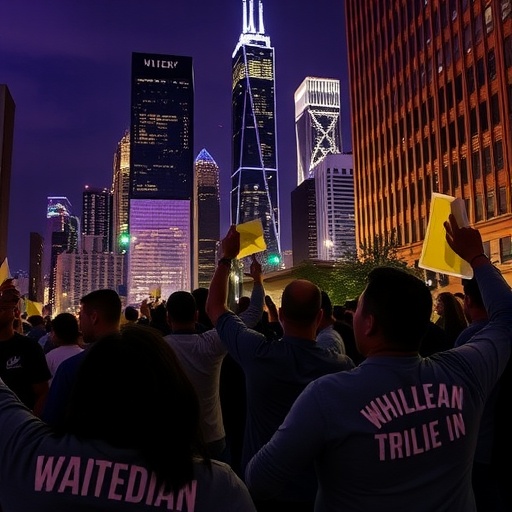Chicago‘s Political Divide Escalates: ICE Raid Chaos and Migrant Housing Failures Fuel Grassroots Uprising
In the heart of Chicago, a city long synonymous with resilient communities and vibrant diversity, a dramatic ICE raid has ignited a firestorm of controversy, deepening the chasm between local leaders and their constituents. Last week, federal agents descended on the bustling Pilsen neighborhood, detaining over 50 individuals in what officials described as a routine enforcement operation. But for residents and activists, it was a stark reminder of the escalating migrant crisis straining the Windy City’s resources and testing its sanctuary city status. As criticism mounts against political elites accused of mishandling migrant housing, new grassroots movements are emerging, demanding accountability and reform in Chicago‘s politics.
The raid, which unfolded under the cover of dawn on a chilly October morning, sent shockwaves through immigrant-heavy enclaves. Eyewitnesses reported helicopters hovering overhead and armored vehicles blocking streets, creating an atmosphere of fear that lingered for days. “It felt like an invasion,” said Maria Gonzalez, a longtime Pilsen resident and community organizer. “These are our neighbors, our friends—people fleeing violence, not criminals.” The operation resulted in 52 arrests, primarily for immigration violations, according to U.S. Immigration and Customs Enforcement (ICE) statements. Yet, the timing couldn’t have been worse, coming amid a surge of over 20,000 migrants bused to Chicago from Texas since 2022, overwhelming city shelters and sparking heated debates over federal versus local authority.
Chicago’s response to the migrant crisis has been a patchwork of emergency measures, but critics argue it’s woefully inadequate. With winter approaching, makeshift shelters in police stations and airports are at capacity, housing more than 5,000 people as of last month, per city data. The ICE raid has only amplified calls for better coordination between federal agencies and local government, highlighting the tensions in Chicago’s progressive politics. Mayor Brandon Johnson, a vocal advocate for immigrant rights, condemned the raid as “an attack on our values,” but his administration faces scrutiny for delays in securing permanent housing solutions.
Inside the Pilsen ICE Raid: Fear and Federal Overreach
The ICE raid in Pilsen, a historic Latino neighborhood known for its murals and thriving arts scene, began at 5 a.m. on October 15th. Agents, backed by local law enforcement, targeted several apartment buildings and a local factory suspected of employing undocumented workers. By midday, the operation had wrapped up, but the emotional toll was immense. Families were separated, children left without parents, and community trust eroded overnight.
According to ICE reports, the raid was part of a broader Midwest initiative aimed at dismantling human smuggling networks. “Our focus is on public safety and removing threats from our communities,” said ICE spokesperson Jennifer Torch, in a statement released hours after the event. However, local advocates dispute this narrative. The Chicago Appleseed Fund for Justice, a nonprofit monitoring immigration enforcement, documented 12 cases of U.S. citizens or legal residents briefly detained due to racial profiling during the raid—a statistic that underscores broader concerns about overreach.
Pilsen’s demographic makeup, with over 70% Hispanic residents according to the 2020 Census, makes it a flashpoint for such actions. Neighborhood leaders report a spike in school absences and clinic visits post-raid, as fear of deportation keeps families indoors. “This isn’t just about one raid; it’s symptomatic of a broken system,” noted Rev. Jorge Gonzalez, pastor at La Villita Church, who sheltered several families during the chaos. His words echo a growing sentiment that federal policies are clashing with Chicago’s sanctuary city ordinance, passed in 1985 and reaffirmed multiple times since.
Economically, the raid’s impact ripples outward. Pilsen’s small businesses, many immigrant-owned, saw foot traffic drop by 30% in the following week, based on preliminary data from the Pilsen Alliance. Owners like Rosa Ramirez, who runs a taqueria on 18th Street, worry about long-term damage. “People are scared to come out. How do we rebuild when trust is shattered?” she asked, wiping down counters in her nearly empty shop.
Migrant Housing Overload: Chicago’s Shelters on the Brink
As the migrant crisis intensifies, Chicago’s housing infrastructure is buckling under the weight of arrivals. Since August 2022, more than 21,000 migrants have been transported to the city by Republican governors in border states, a political maneuver that has turned Chicago politics into a national spectacle. The city’s Department of Family and Support Services reports that current shelters, including the sprawling facility at the former Holiday Inn on Chicago Avenue, are operating at 110% capacity, with families sleeping on floors and cots in hallways.
Statistics paint a grim picture: Over 2,000 children are among the sheltered migrants, many arriving with trauma from perilous journeys through Mexico. Health officials have noted a 25% increase in respiratory illnesses in shelters this fall, attributed to overcrowding and the onset of cold weather. “We’re one blizzard away from a humanitarian disaster,” warned Dr. Elena Vasquez, director of the Chicago Migrant Health Coalition, in a press conference last Tuesday.
The Johnson administration has allocated $150 million in federal aid for migrant support, but distribution has been criticized as inefficient. A recent audit by the city’s inspector general revealed that 40% of funds intended for housing vouchers went unspent due to bureaucratic delays. Alderman Byron Sigcho-Lopez, representing the 25th Ward which includes Pilsen, has been vocal about the need for more state intervention. “We can’t keep patching holes with taxpayer money while Washington plays politics,” he said during a city council meeting.
Community responses have filled some gaps. Volunteer groups like the Chicago Mutual Aid Network have distributed over 10,000 meals and 5,000 hygiene kits since the crisis began. Yet, these efforts highlight the strain on grassroots organizations, which lack the resources for long-term solutions. One innovative program, the Pilsen Welcome Center, offers legal aid and job training to 300 migrants monthly, but funding cuts threaten its survival.
- Key Challenges in Migrant Housing:
- Overcrowded shelters leading to health risks
- Delays in work authorizations, keeping migrants in limbo
- Rising costs: City spending on the crisis has topped $250 million
- Winter preparations: Only 60% of promised heated tents are ready
These issues have not only strained budgets but also exacerbated racial and class divides, with some longtime Black and Latino residents feeling sidelined in the resource scramble.
Political Backlash: Elites Under Fire in Chicago’s Halls of Power
The ICE raid and ongoing migrant crisis have thrust Chicago’s politics into the national spotlight, with local elites facing unprecedented scrutiny. Mayor Johnson, elected on a progressive platform promising bold action on social justice, now grapples with accusations of hypocrisy. His office’s slow rollout of a $40 million housing plan—criticized by the Chicago Tribune as “too little, too late”—has eroded support among his base.
At a heated city council session on October 20th, over a dozen aldermen demanded an emergency summit with federal officials. “This raid was a direct challenge to our sanctuary policies, and the mayor’s response has been muted,” charged Alderman Gil Villegas, a mayoral contender. Polling from Loyola University Chicago shows Johnson’s approval rating dipping to 42% among Latino voters, a 15-point drop since summer, largely tied to the crisis.
Governor J.B. Pritzker has pledged an additional $200 million from state coffers, but tensions with the feds persist. During a visit to a South Side shelter, Pritzker stated, “Illinois stands with our newcomers, but we need Congress to act on comprehensive immigration reform.” Meanwhile, conservative voices, including U.S. Rep. Jesús “Chuy” García’s opponents, argue that sanctuary policies invite chaos, pointing to a 18% rise in emergency calls related to migrant encampments.
The political fallout extends to the 2024 elections, where the migrant crisis is emerging as a wedge issue. Candidates from both parties are courting grassroots voters, with ads highlighting raid footage and shelter overflows. A recent survey by the Chicago Council on Global Affairs found 62% of residents believe the city is unprepared for future influxes, fueling demands for policy overhauls.
Grassroots Surge: Communities Mobilize Against the Crisis
In the wake of the ICE raid, grassroots movements are blossoming across Chicago, transforming anger into action. Groups like the Chicago Community Justice Alliance have organized daily vigils outside City Hall, drawing hundreds who chant slogans like “Housing for All, Not Deportations.” Founded just weeks ago, the alliance boasts 2,000 members and has partnered with national organizations such as the ACLU to provide pro bono legal services.
One standout initiative is the Migrant Solidarity Network, a coalition of neighborhood councils from Pilsen to Little Village. They’ve raised $75,000 through crowdfunding to establish pop-up resource centers offering ESL classes, mental health support, and job placement. “We’re not waiting for politicians; we’re building the solutions ourselves,” said network co-founder Jamal Thompson, a South Side activist whose group has assisted 500 families since the raid.
Protests have remained peaceful but persistent, with a march on October 22nd attracting 1,500 participants who blocked Michigan Avenue briefly to demand an end to ICE operations in sanctuary cities. Social media has amplified these efforts, with #ChicagoStandsTogether trending locally and garnering over 50,000 posts. Influential voices, including celebrities like Lin-Manuel Miranda, who retweeted raid victim stories, have boosted visibility.
Challenges persist for these movements. Internal debates over strategy—confrontational vs. collaborative—have surfaced, and funding remains precarious. Yet, their impact is undeniable: City officials have fast-tracked 200 housing vouchers in response to grassroots pressure, a small but symbolic win.
- Notable Grassroots Actions:
- Vigils and marches demanding raid accountability
- Crowdfunded aid distribution reaching thousands
- Legal clinics challenging deportations
- Advocacy for state-level sanctuary expansions
These efforts represent a shift in Chicago’s politics, empowering everyday citizens to reshape the narrative around the migrant crisis.
Looking Ahead: Pathways to Unity in Chicago’s Fractured Landscape
As Chicago navigates the fallout from the ICE raid and the deepening migrant crisis, the path forward hinges on bridging divides in its politics. Experts predict a special legislative session next month, where aldermen will debate expanding shelter capacities and negotiating with the Biden administration for more aid. The Illinois Policy Institute forecasts that without federal intervention, costs could balloon to $500 million by mid-2024, straining an already tight municipal budget.
Grassroots leaders are pushing for innovative solutions, such as converting vacant commercial spaces into affordable housing—a model piloted in New York with mixed success. Community forums, scheduled across all 50 wards starting November 1st, aim to incorporate resident input, potentially averting further unrest. “This crisis could be a turning point for inclusive governance,” suggested political analyst Dr. Maria Lopez from the University of Chicago, who advocates for public-private partnerships to streamline migrant integration.
On the federal front, advocacy groups are lobbying for the passage of the Farmworker Modernization Act, which could legalize thousands of Chicago’s undocumented agricultural workers. Locally, the Johnson administration has outlined a 10-year plan to build 1,000 units of dedicated migrant housing, though skeptics question its feasibility amid zoning battles.
Ultimately, Chicago’s resilience will be tested not just by logistics, but by its ability to foster empathy across divides. As one anonymous shelter volunteer put it, “We’ve always been a city of immigrants. Now, we need to live up to that legacy.” With elections looming and movements gaining steam, the coming months promise pivotal changes in how the city addresses its most vulnerable.







